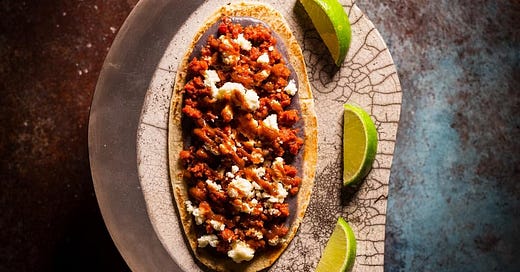Q+A and Recipe: Andréa Lawson Gray on Writing a James Beard Award-Winning Cookbook with Rogelio Garcia
Interview with a visionary!
Today, we’re thrilled to present a Q+A with Andréa Lawson Gray and a recipe from the book she wrote with Rogelio Garcia, Convivir: Modern Mexican Cuisine in California’s Wine Country. They just took home a James Beard Foundation Book Award in the Professional and Restaurant category, and Andréa actually saw this honor coming before the book was written! Let’s hear from her about it:
Food Book Club/Tamara Palmer: Can you talk about how you had already visualized James Beard success before you asked Rogelio to collaborate? Is this a technique you apply often in life?
Andréa Lawson Gray: Reflecting upon your question, it may well be a technique I have employed often but not quite with the same level of consciousness. I have always forged ahead in areas where I had no experience but lots of desire — an example would be becoming a chef, a challenge I undertook out of necessity when I was a single mom raising 3 kids in the most expensive city in the country. I saw an opportunity and no reason I couldn’t figure it out, so I went for it. Ten years later, I was cooking food that many of my high-net-worth clients equated with Michelin-starred dining experiences they had had. So yes, visualizing success is a pathway I have always embraced. After I had turned in the manuscript for Convivir, which I was so proud of and felt was my best work to date, I literally lay in bed at night picturing what I was going to wear to the James Beard Awards. May seem silly, but hey, maybe it worked!
What did it feel like to actually be on stage, accepting the award with him?
To start with, I want to express how grateful I am that the JBF recognizes both the author and the writer equally. This is rare. We writers do all the heavy lifting, and ask anyone who has written a cookbook with a working chef, it is like herding cats. And yet most of the media exposure doesn't give us mention. So that felt really important. I think being on that stage was the first time I felt like I had equal billing, and that is important to me. Of course, I am incredibly grateful to Rogelio and our work together, and yes, this was a huge moment for both of us — but for me, to be on that stage, to have Alexander Smalls sing out the title of a book that I named, to have Padma put that medallion around my neck, it really did feel to me like I had finally arrived as a food writer. Being self-taught in both disciplines (cheffing and food writing) one does seek outside validation, and that this was it for me.
What was the best part of working with Rogelio? Do you think more books are in your future together?
Co-authoring is a really intimate experience. Working with Rogelio was amazing, especially as we collaborated on recipe ideas. We both cook the same style of food, modern Mexican cuisine, which is why I invited him to write a cookbook with me. I had been trying to get a modern Mexican cookbook out there since 2018 but lacked the platform needed to attract publishers, something Rogelio brought to the table. But beyond that, there was so much excitement and joy in coming up with the recipe ideas, working through the stories together and just knowing that he respected my culinary chops, that meant so much to me.
And yes, we have another book proposal that we are about to send out into the world. I can't share more now but it is a first-to-market concept that we are both super excited about!
Which recipes from the book are in your personal heavy rotation?
I do use some of the recipes when designing menus for the dinner parties I produce. My go-tos are the Pistachio-crusted Duck Breast with Black Cherry Mole (this is a nice one because the duck recipe is Rogelio's and the mole recipe is mine), the Mexican Rice a La Robles, which is Rogelio's mom's recipe because those stuffed peppers are like delightful little gifts for each dinner guest, the Stuffed Chiles (Chiles Rellenos) Forbidden Rice Pilaf which is a recipe we also developed together, and the Branzino with Shrimp Mousse.
Could you recommend cookbooks from any era that have been meaningful to you that our readers might enjoy?
For a basic (and beyond) understanding of Mexican culinary basics, I love Roberto Santibanez's Truly Mexican. For inspirational, transportive photography and recipes, Hartwood: Bright Flavors from the Edge of the Yucatan, by Eric Werner and Mya Henry, with Christine Muhlke and Oliver Strand. And because Guelaguetza is one of my favorite restaurants, and I truly do recognize Oaxaca as the heart of so much of Mexican cuisine, Oaxaca: Home Cooking from the Heart of Mexico by Bricia Lopez and Javier Cabral.
*
Recipe from Convivir: Modern Mexican Cuisine in California’s Wine Country by Rogelio Garcia with Andréa Lawson Gray
SQUASH BLOSSOM AND MAITAKE RICE PILAF WITH POBLANO CHILE AND KALE
This unusual pilaf is made with flavorful maitake mushrooms, best described as woodsy, or earthy and peppery, with a distinctive aroma and succulent texture. They can be difficult to source and are pricey, but they are worth the time and money. Maitakes work beautifully with the kale, which is also earthy and peppery and contrast nicely with the mild spice of poblanos for a perfectly balanced dish. The squash blossoms add a beautiful finishing touch.
Makes 4 to 6 servings
2 tablespoons unsalted butter
3 tablespoons olive oil
1 cup (190 g) jasmine rice
1 yellow onion, finely diced
2 cups (130 g) stemmed and roughly chopped dinosaur (Tuscan) kale
2 whole maitake mushrooms, roughly chopped
1 poblano chile, charred, peeled, stemmed, and seeded, then cut into 1/4-inch (6-mm) dice
2 cloves garlic, minced
1 zucchini, cut into 1/4-inch (6-mm) dice
1 teaspoon sweet smoked paprika
1 1/2 cups (360 ml) chicken stock or water
2 teaspoons kosher salt
16 squash blossoms
1 cup (100 g) grated queso Cotija or Parmesan cheese
Heat a large skillet with a lid over medium-high heat. When the pan is hot, melt the butter with the oil. Add the rice, reduce the heat to medium, and toast, stirring occasionally, for 5 minutes. The rice will first turn translucent and then start to turn light brown. Add the onion, kale, maitake, poblano, and garlic and cook, stirring often, for 3 minutes. Add the zucchini and paprika and cook, stirring, for 1 minute. Pour in the stock, bring to a simmer, and stir in the salt. Reduce the heat to medium-low, cover, and cook for 10 to 12 minutes, or until the liquid has been absorbed and the rice is tender. Remove from the heat and let sit, covered, for another 10 minutes.
While the rice sits, remove the stamens and pistils from the squash blossoms and rinse them.
Uncover the skillet, taste the pilaf, and adjust the seasoning with salt if needed. Fold in the whole squash blossoms and cheese and serve at once.
Previously in our Q+A series:
Soleil Ho on Writing The Memory of Taste with Tu David Phu and New Worker-Owned Media Company COYOTE
Hetal Vasavada on Desi Bakes
Lenny Rosenberg and Adaeze Nwanonyiri on It's a Sweet World: Recipes from Around the Globe at Bea’s Bakery.
Georgia Freedman on Snacking Dinners and Smart Recipe Development
Ying Chang Compestine on Her Graphic Cookbook, Buddha Jumps Over the Wall, and Other Curiously Named Classic Chinese Dishes (+ Recipe!)
Martin Yan Shares His Astonishing 36th and 37th Cookbooks with Us
S.H. Fernando Jr. on Rice & Curry: Sri Lankan Home Cooking (and Introducing the Cuisine to Bourdain)
Tony Ramirez on Backyard BBQ With Fire and Spice
Vanessa Lavorato on How to Eat Weed & Have a Good Time








